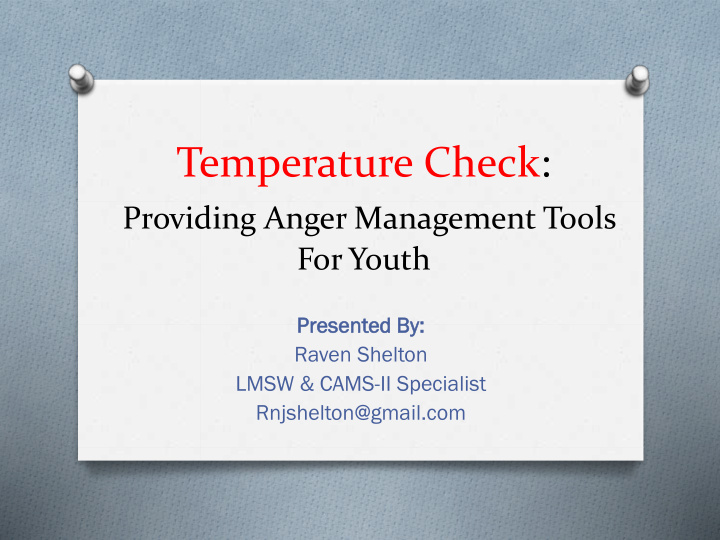



Temperature Check: Providing Anger Management Tools For Youth Presented ed By: Raven Shelton LMSW & CAMS-II Specialist Rnjshelton@gmail.com
What is Anger? O Anger is a “ psychobiological emoti tional onal stat ate e consisting of feelings varying in intensity from mild irritation or annoyance to intense fury and rage, accompanied by activation of neuroendocrine processes and arousal of the autonomic nervous system.”
Anger is a 3-Part Process O Pa Part t 1-Trigg rigger er-A stimulus — such as a person, place or thing — that contributes to an unwanted emotional or behavioral response. O Pa Part t 2-Inter erpre pretai taion on- Deciphering the intent of the trigger. Freeze, Flight, or Fight O Pa Part t 3-Emo moti tion on-Behavioral response Trigger + Interpretation = Emoti tion on
Types of Triggers O Emoti tional onal triggers iggers are what happen to you, like when someone verbally puts you down. O Intern ernal l trigger riggers s are the messages you give yourself, or thoughts that get you all worked up. They are sometimes based on assumptions, incorrect information, or dysfunctional thinking. O Physic sical al Triggers iggers occur when personal space is violated
Interpretation
Interpretation Types of Anger Common Among Youth O Sur urviv ival al An Anger er-when you are physically attacked and your body might be injured O Impo mpotent ent An Anger er-when you feel threatened, utterly helpless and unable to deal with the situation so you become angry instead. O Attachme chment nt An Anger er-when you feel threatened because you might be abandoned or rejected by someone you care about. O Shame ame An Anger er-when you feel humiliated, embarrassed or ridiculed and your self-esteem plunges and you become angry in order to cut off the bad feelings.
Basic Ways Youth Deal with Anger O Stuf uffin ing-Individual frequently swallows their anger or simply does not allow oneself to experience the anger O Escalat alating-Individual lets their anger out and does not hold anything in. This person dumps their feelings onto whoever is around at the moment O Managing ging-Individual expresses their anger in a socially appropriate and healthy way
Anger Cycle
Trigger Check ✔ O Utilize activities and conversation to help youth identify their own triggers O Let them use their own words regarding their anger. This helps them to begin practice effective communication. O Validate their triggers O Have youth identify the physical change that occurs in their body when triggered
Checking the Temperature: Creative Therapeutic Group Check in’s: Weather Report Rose, Bud, Thorn Number Scale What’s your playlist? Thumbs up Movie Genre One word to describe how you are feeling about the day
Individual De-escalation Techniques Twenty ty Minut utes es-On average, it can take 20 minutes es for a person who has experienced an angry state of arousal, to move from functioning from the emotional area to the thinking area of the brain. O Remove youth away from the environment that triggered their anger O Work through silence-just keeping a person company while they are angry is a form of de-escalation. Presence can be more comforting than words. O De-escalation is not all about verbal communication its also about non verbal communication. Keep talking to the minimum instead. O Be mindful of your body language and facial expression O Allow youth to talk and you listen O Listen for triggers. O Empathize or share an anecdote O Key Question: What t could you have e done e differently? erently? O Utilize music, stress balls O Games
Recommend
More recommend